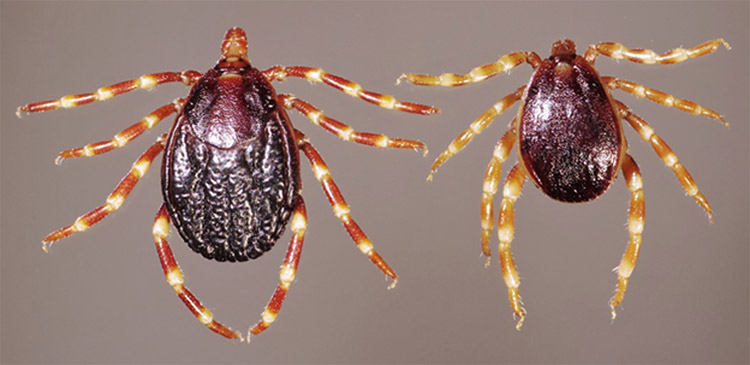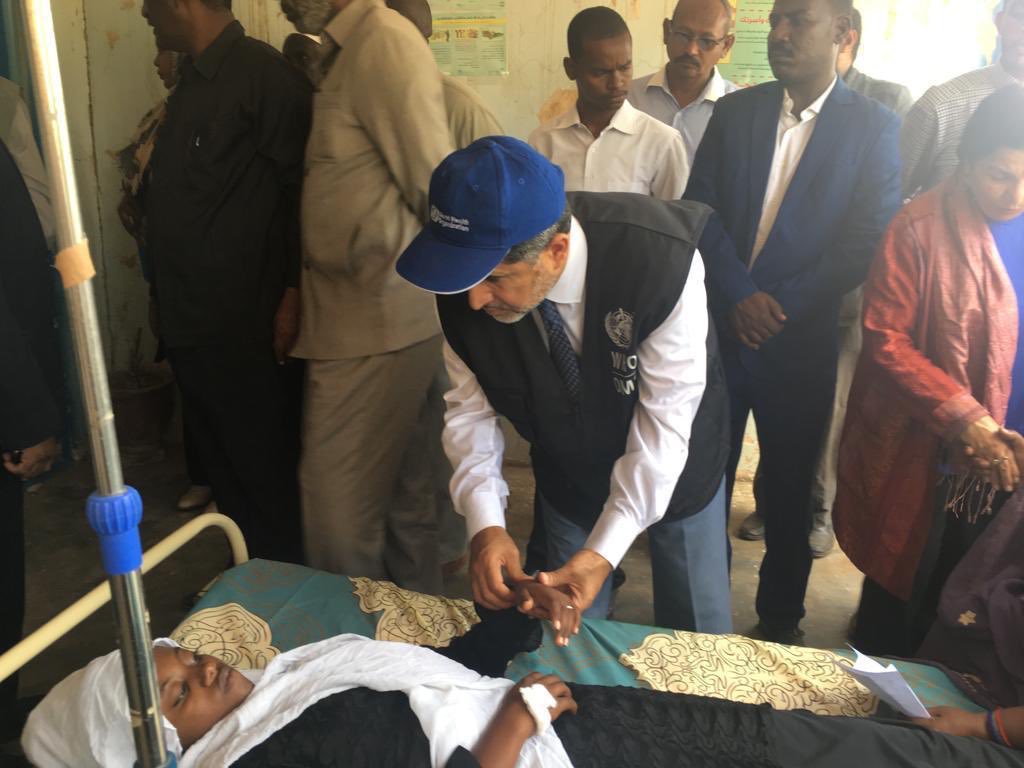|
 Hyalomma ticks are the main vector for CCHF (Photo: Daktaridudu/Wikimedia Commons) Hyalomma ticks are the main vector for CCHF (Photo: Daktaridudu/Wikimedia Commons)
Crimean-Congo haemorrhagic fever (CCHF) is the most widespread tick-borne viral disease affecting humans. The causative agent, CCHF virus (a Nairovirus of the Bunyaviridae family) is transmitted mainly by ticks (Hyalomma) and livestock animals. Human-to-human transmission can occur, usually in the health care setting, resulting from close contact with the blood, secretions, organs or other bodily fluids of infected persons. The disease begins with a sudden onset of influenza-like symptoms which may progress to severe bleeding and can be fatal (current case fatality rate is 10-40%) if not treated.
In the Eastern Mediterranean Region, sporadic human cases and outbreaks of CCHF have been reported, in the past, from Afghanistan, Islamic Republic of Iran, Iraq, Kuwait, Oman, Pakistan, Saudi Arabia, Sudan and the United Arab Emirates. So far, five genotypes of CCHF virus (genotype-1, 2, 3, 4 and 7) have been detected in the countries of WHO's Eastern Mediterranean Region. In some countries, the trend of CCHF has been steadily increasing in recent years. WHO is working with partners to support CCHF surveillance and outbreak response activities.
Containing and preventing outbreaks is difficult because of the lack of a safe and effective vaccine, widespread presence of tick vectors, and the fact that the infection mostly goes unnoticed in domestic animals. The focus is therefore on awareness and education efforts with regards to reducing transmission risk. Management of CCHF in humans mainly consists of treating symptoms, although the antiviral drug ribavirin has been used to treat the infection with apparent benefit.
WHO is working with partners to support surveillance, diagnostic capacity and outbreak response activities in the Region, as well as documentation to help disease investigation and control.
|
|
 |
 |
|
 Dr Ahmed Al-Mandhari, WHO Regional Director for the Eastern Mediterranean, visits a health center in Kassala, Sudan, to see patients treated for Chikungunya. (Photo: WHO) Dr Ahmed Al-Mandhari, WHO Regional Director for the Eastern Mediterranean, visits a health center in Kassala, Sudan, to see patients treated for Chikungunya. (Photo: WHO)
Chikungunya is a viral disease transmitted to humans by Aedes mosquitoes. It causes fever and severe joint pain, which is often debilitating and may persist for several months, or even years. Other symptoms include muscle pain, headache, nausea, fatigue and rash. Joint pain is often debilitating and can vary in duration. The disease shares some clinical signs with dengue fever and zika virus infection, and can be misdiagnosed in areas where these are common.
Although the disease, which was first described during a 1952 outbreak in southern Tanzania, mostly occurs in Africa, Asia and the Indian subcontinent, a major outbreak in 2015 affected several countries in the Americas. In the Eastern Mediterranean Region, chikungunya was first found during serological surveys conducted in Pakistan in 1983. In 2011, Yemen reported the first outbreak in the Region resulting in over 15000 suspected cases and 104 suspected deaths. In 2017, Pakistan reported a major outbreak with over 8000 cases affecting multiple provinces. Sporadic cases of chikungunya have been reported also from Saudi Arabia and Sudan. In 2018, Sudan also reported an outbreak of chikungunya in its eastern states.
There is currently no cure for chikungunya and treatment is focused on symptom relief.
Since the proximity of mosquito breeding sites to human habitation is a significant risk factor for chikungunya, prevention and control relies heavily on reducing the number of natural and artificial water-filled container habitats that support breeding of the mosquitoes. People travelling to risk areas should make use of repellents, wear long sleeves and pants, and ensure rooms are fitted with screens to prevent mosquitoes from entering. During outbreaks, insecticides may be sprayed to kill flying mosquitoes, applied to surfaces in and around containers where the mosquitoes land, and used to treat water in containers to kill the immature larvae.
WHO helps countries to respond to chikungunya with outbreak management plans, technical support and training, direct and published guidance, and improvement of reporting systems.
|
|
Overview |
 |
 |
Keep closed environments smoke-free
WHO has selected “Smoke-free environments” as the theme for World No Tobacco Day 2007 to:
emphasize the importance of 100% smoke-free environments
highlight the negative health effects of exposure to second-hand smoke
expose the tobacco industry’s attempts to skew scientific evidence in their favour to slow down implementation of smoke-free legislation
urge Parties to implement the WHO Framework Convention on Tobacco Control (FCTC), in particular Article 8 to protect the public from exposure to tobacco smoke.
Tobacco is the only legal consumer product that kills when used exactly as intended by the manufacturer. World No Tobacco Day will help to save more lives and to limit the damage caused by tobacco use.
The key messages of this year's World No Tobacco Day are:
Second-hand tobacco smoke kills and causes serious illnesses.
100% smoke-free environments are the only effective strategy to reduce exposure to tobacco smoke.
Non-smokers are the majority and have a right not to be exposed to other’s smoke.
Smoking bans help prevent people, especially youth from starting to smoke.
Clean air is everyone’s right.
All countries have a moral obligation to ratify and fully implement the WHO FCTC to save lives. |
|
|
Overview |
 |
 |
Stay on the road: Implement the WHO Framework Convention on Tobacco Control
WHO has selected "The WHO Framework Convention on Tobacco Control (FCTC)" as the theme for World No Tobacco Day 2011 to:
highlight the importance of the treaty
stress Parties' obligations under the treaty
shed light on the various guidelines and what is needed at national level to strengthen the treaty
promote the essential role of the Conference of the Parties and WHO in supporting country efforts.
Tobacco is the only legal consumer product that kills when used exactly as intended by the manufacturer. World No Tobacco Day will help to save more lives and to limit the damage caused by tobacco use.
The key messages of this year's World No Tobacco Day are:
All countries have a moral obligation to ratify and fully implement the WHO FCTC to save lives.
Treaty obligations should be translated into realities at country level through the creation of national mechanisms.
Organizations, institutions and civil society should join forces to support government in effective implementation of the WHO FCTC. |
|
Awards |
 |
 |
|
Every year, the World Health Organization (WHO) presents awards to key people and/or organizations that have made valuable contributions to tobacco control and have helped make World No Tobacco Day and its theme a great success. These awards are an expression of WHO's appreciation of the great time and effort that these contributors have invested in the campaigns, as well as in fighting tobacco.
This year, six World No Tobacco Day awards were presented to:
Her Excellency Dr Moushira Khattab, Minister of Family and Population Affairs, Egypt
Iranian Anti Tobacco Association, Islamic Republic of Iran
Dr Hiba Ayub, Head of the Tobacco Control Department, Ministry of Health, Jordan
Dr Hamdeyah A. S. Al Fadli, Member of the Anti-smoking National Programme, Kuwait
Roteract District 2450/Christine Gabriel Arzoumanian, Lebanon
Dr Mounira Nebli, National Coordinator for the Tobacco Control Programme, Primary Health Care Direction, Tunisia
These individuals and/or organizations have been at the forefront of tobacco control for years. They have contributed to many initiatives to raise public awareness of the ill health effects of tobacco use and exposure to its smoke, and to reduce tobacco consumption. Their work has been particularly targeted at women and young people. |
|
|
|
|
|
|
Page 50 of 93 |